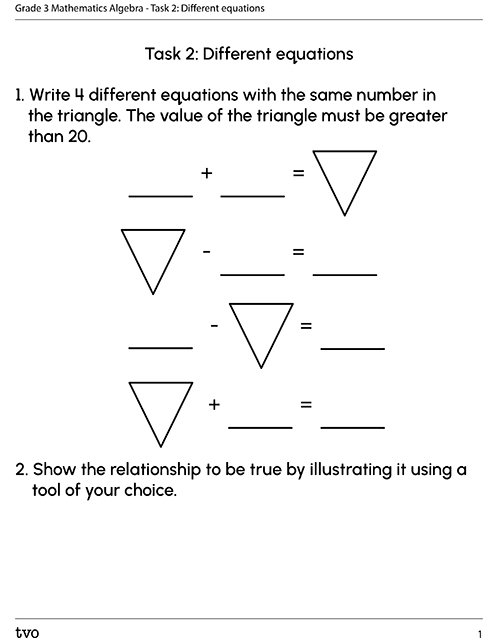Minds On
Balancing equations
Student Tips
Did you know?
The word variable means an unknown value in an expression or equation.
For example:
In this example, “x” is the variable, as it takes the spot for an unknown value or a missing number.
Let's consider this balance scale and equation with two missing numbers or variables.

There is a balance scale with coloured cubes on both sides. The scale is unbalanced and tipped towards the right side. In the left pan, there are 15 yellow cubes, in 3 rows of 5 cubes each. In the right pan, there are 20 green cubes, in 4 rows of 5 cubes each. Beneath the scale is an equation. The equation is 15 plus question mark, equals 20 plus question mark.
Brainstorm
What do you think?
While exploring the balance scale, reflect and discuss the following questions:
- What do you notice about this picture and this equation?
- How can you make the left side of the scale equal the right side?
- Is there more than one possible answer?
Record your ideas in a notebook or a method of your choice.
You may wish to use the hundred chart, counters, blocks, or another method of your choice to help count and support your thinking!
Action
Addition and subtraction
Counters
Let's examine the following equation:
(Blank)
I could determine the value of the variable or the blank in a variety of ways.
Let’s start with the counters below.


So, we started with 11 counters, took some away, and ended up with 5 remaining.
I can circle the 5 remaining, and count what was taken away, 6 counters.
5, 6, and 11 are a fact family. If you know one fact in a fact family, you can determine the others.
Number lines
Let’s explore another example using number lines:
(Blank)
Now, let’s use a number line.
The example shows that we can start counting from 10 to 21. We also needed to figure out how far apart 10 and 21 are.
Here, skip counting is shown as a method to find the missing number.
This is part of the fact family:
Therefore 10, 11, and 21 are a fact family. If you know one fact in a fact family, you can determine the others.
Determine the rest of the fact family.
Select the correct answer, then press “Check Answer” to see how you did.
Student Tips
Did you know?
Addition and subtraction have an inverse relationship.
That means that we can use the opposite operation to help you solve a problem with a missing number.
For example: You are given 7 + (Blank) = 10
Since this is an addition equation, we can use the opposite operation to help find the missing number.
Our opposite operation for addition is subtraction, so we make a subtraction equation to find the missing number, like this: 10 − 7 = (Blank)
Now, we can solve this problem and find the missing number.
10 − 7 = 3

Your turn!
Follow the steps for the following tasks.
You may wish to use the hundreds chart, counters, blocks, or another method of your choice to help count and support your thinking!
Task 1: Greater than 20
Recall that a variable is used to represent an unknown quantity.

This is a template for a fact family. There are 4 rows, and each row is made up of 2 blanks and 1 square, separated by different math symbols. The first (and top) row is: blank plus blank equals square. The second row is: square minus blank equals blank. The third row is: square equals blank plus blank. The fourth (and bottom) row is: square minus blank equals blank.
- Complete the fact family. The number represented by the square must be a number greater than 20.
- Show the relationship to be true by representing it using a method of your choice.
Let’s explore a Hundred Chart together! Your teacher will show you how to use the Hundred Chart and then you can try using it yourself!
Complete the Task 1: Greater than 20 in your notebook or use the following fillable and printable document. You can also use another method of your choice.
Task 2: Different equations
Write four different equations with the same number in the triangle. The value of the triangle must be greater than 20.

This is a template for 4 different equations. There are 4 rows, and each row is made up of 2 blanks and 1 triangle, separated by different math symbols. The first row is: blank plus blank equals triangle. The second row is: triangle minus blank equals blank. The third row is: blank minus triangle equals blank. The fourth and last row is: triangle plus blank equals blank.
Show the relationship to be true by illustrating it using a method of your choice.
Let’s explore a Hundred Chart together! Your teacher will show you how to use the Hundred Chart and then you can try using it yourself!
Complete the Task 2: Different Equations in your notebook or use the following fillable and printable document. You can also use another method of your choice.
Task 3: Word problem
Let's solve the following word problems. You can use a method of your choice to support your thinking!
Select the correct answer, then press “Check Answer” to see how you did.
Consolidation
How many balloons?

Reflect on the following word problem:
One friend went to the store and purchased 11 balloons. A second friend purchased some more. Together they had 29 balloons in total.
- How many did the second friend purchase?
- Use the numbers in the problem to help you explain how addition and subtraction are related. How can you use this relationship to solve problems?
You may wish to use the hundreds chart, counters, blocks, or another method of your choice to help count and support your thinking!
Record your ideas in your notebook or another method of your choice.
Let’s explore a Hundred Chart together! Your teacher will show you how to use the Hundred Chart and then you can try using it yourself!
Reflection
How do you feel about what you have learned in this activity? Which of the next four sentences best matches how you are feeling about your learning? Press the button that is beside this sentence.
I feel...
Now, record your ideas about your feelings using a voice recorder, speech-to-text, or writing tool.

